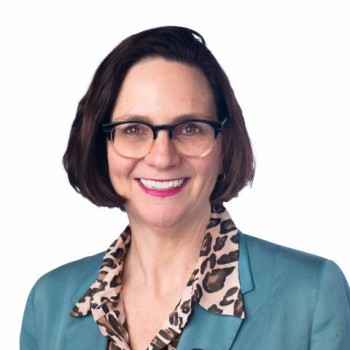You are looking at an archived version of our site. Please visit thepcc.org for a fresh, new experience!
You are here: Array » Primary Care Champion: ...
Primary Care Champion: Emily M. Godfrey
A shorter version of this Q&A was published in the May 2022 Executive Member Update, the monthly enewsletter for PCC Executive Members. Below is the full article. Each month in PCC's newsletters, the PCC provides a short profile of an individual who works in primary care. It is a way of recognizing the dedication and passion that clinicians, advocates, and others have for primary care and connecting people in the PCC community to people like them. Dr. Godfrey was one of the speakers who provided a range of perspectives on primary care during the March 29 online launch of PCC’s new campaign, Better Health — Now.
Emily M. Godfrey, MD, MPH
Associate Professor of Family Medicine and Obstetrics and Gynecology at the University of Washington, Seattle
What does it mean to you to be a primary care champion?
I believe that primary care clinicians are the cornerstone of all healthcare. Understanding patients’ personal stories and needs throughout the whole life cycle is central to supporting their physical and psychological health. This includes access to early childhood care, healthy nutrition and exercise for teenagers and young adults as well as comprehensive and compassionate care during our reproductive years and our changing bodies as we age.
Primary care doctors help their patients understand when a referral to a specialist is merited, and clinicians work with families to see emotional and physical health maintenance as a multi-level process rather than a series of unrelated concerns.
Tell us about your experience as both a primary care physician and specialist.
I have a unique perspective because for 6 years I have worked as a hospital-based specialist for part of the week and as a community primary care provider for the other part of the week in the same health system. And from my experience, there is a world of difference between the two settings.
For example, the time in which I get to see my patients in specialty care and primary care is vastly different. As a specialist, I have 40 minutes to see most patients, who are coming to see me for a single complex issue. In primary care, I have only 15 minutes to see most patients who are coming in for four to five issues. These time differences exist because 40 minutes of a specialist’s time is paid for at a much higher rate than 40 minutes with a primary care clinician. Because time with the primary care clinician is not valued at the same rate as a specialist, primary care clinicians must see many more patients per day just to stay in business.
Additionally, because of these huge differences in how services are covered by insurance and how clinics get paid, specialists have many more resources to support their administrative costs. Specialist clinics can hire highly skilled registered nurses and staff who can manage most of the messages and requests that come in from patients throughout the day. This allows specialty doctors and clinicians to focus on the patients they are seeing that day and not be forced to divide their time between giving care and completing paperwork.
The truth is, many primary care clinicians find they can no longer keep up with the pace of seeing so many patients in a single day, only to have hours of administrative work waiting for them after a full day of clinical care. The result is a primary care clinician shortage. On the other hand, patients too often are waiting a long time to get in to see their primary care clinician, only to find that the interaction is quick and superficial. It is frustrating for me and my patients when I have to ask them to come back to address any issues we were not able to get to in a 15-minute appointment. Then I worry if those patients cannot follow up. When my patients cannot access care when it is needed, they are not getting the high-quality care that every individual in the U.S. deserves.
What message do you have to others about improving primary care?
Don’t give up! Change is possible if we speak with a unified voice and educate the public and our lawmakers and legislators about why they need to value primary care. The path to making improvements has challenges, but these are not permanent roadblocks that cannot be surmounted. Despite these challenges, I still love my job as a primary care physician because I feel that I have a chance to build lasting relationships. I always strive to help my patients to receive personalized, high-quality and accessible care.
When people can see their primary care clinician as their personal partner and steward in health care and not just a gatekeeper to specialists, we will progress toward a healthier, more equitable society.

Recent News
August 16, 2024
August 12, 2024
July 16, 2024
May webinar highlights: “The Commercial Market: Alternative Payment Models for Primary Care” Nate Murray explains w… https://t.co/KX9Wi2w6oY —
2 years 6 months ago
@CMSinnovates’ primary care strategy is rooted in a 2021 @theNASEM’s report which called #primarycare “foundational… https://t.co/glbPxvCysg —
2 years 6 months ago
@CMSinnovates has a new #primarycare strategy, envisioning “ACO-based primary care model tests that may focus on pr… https://t.co/aJGF1z411l —
2 years 6 months ago
- Page 1
- ››
Secondary menu
Copyright © 2024 Primary Care Collaborative




